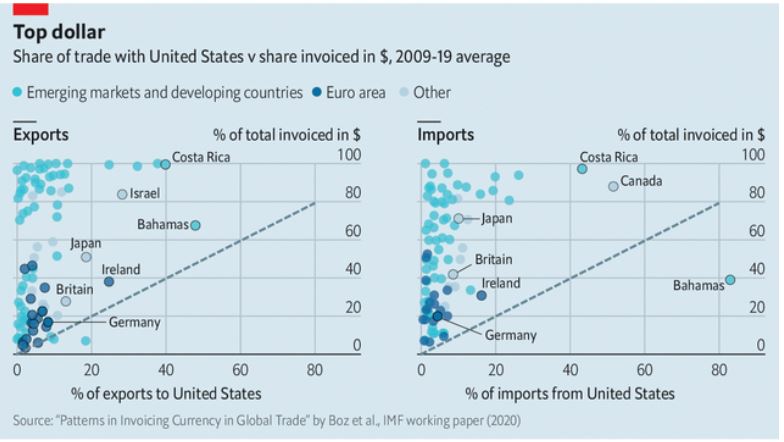Traditional economic theory holds that crashing currencies have a self correcting mechanism. More expensive imports drive new demand for home made replacements, helping to boost the economy. Additionally, devolution makes exports comparatively less expensive for buyers abroad. Yet experience in a world where most trade is invoiced in dollars contradicts this idea, as a recent article in The Economist recently noted. Empirical research has led to an updating of economic theory, with important implications for investors taking on EM currency exposure.
Theory and Practice
The standard economic model for trade and currencies used to be the Mundell Fleming Model. This model assumed prices in international trade would be in the exporters currency. Symmetry in currency choice in payment patterns was known as Grassmans law.
A Colombian devaluation, say, would immediately turn peso-priced batteries into bargains abroad, encouraging foreign buyers to scoop up more of them. Meanwhile shoppers in Bogotá wanting to buy Brazilian t-shirts would resent being made to fork out more pesos to cover the price fixed in real.
Based on this logic, Colombia’s finance minister called the Colombian Peso’s 2014 collapse a “blessing in disguise. However, reality turned out differently, as an IMF report noted:
For Colombia, depreciation raises export volumes only minimally but raises export receipts in pesos. Using the framework, the implications of exchange rate depreciation are related to Colombia being a small open economy exporter of commodities as well its manufacturers’ pricing decisions. First, traditional exports comprise oil and other commodities that are priced in foreign currency. Colombia is a price taker in the global commodity market with fixed capacity at least over the medium run.
Subsequent emprical research indicated that Grassman’s law didn’t hold.
In the mid-2000s Linda Goldberg and Cedric Tille of the Federal Reserve Bank of New York compiled data describing 24 countries in the late 1990s and early 2000s. This confirmed that Grassman’s Law was wrong: exports were not generally priced in the currency of the country they came from. In 2001, for example, they found that South Korea invoiced 82% of its imports in dollars, despite only 16% of its imports coming from America.
Other work confirmed and updated their findings: the dollar has a huge role as a “vehicle currency” in which to invoice transactions to which no Americans are party, particularly in developing countries (see chart). Gita Gopinath of the IMF has compiled data covering just over half of world trade to show that the dollar’s share of invoicing was 4.7 times larger than America’s share of the value of imports, and triple its share of world exports. Another IMF study showed that the dollar’s share has not decreased in step with America’s declining share of overall trade.
Indeed the worlds of finance and trade are intertwined. Exporters borrowing in dollars will want to price their foreign sales in the same currency, to protect against a sudden devaluation which would increase the value of their debt
Implications for Emerging Market Investors
Emerging market investors can’t depend on depreciation to increase exports, unless they are priced in the local currency rather than dollars. Yet commodities are generally priced in dollars, as are many other commonly traded goods. From the Economist article:
Around the world invoicing imports in dollars means that it is devaluations against the greenback, rather than against the currency of the country you are trading with, that count. Emine Boz of the IMF, Ms Gopinath and Mikkel Plagborg-Muller of Princeton University found that prices of imported goods were relatively unresponsive to bilateral exchange-rate movements. Over short-term horizons they were six times more sensitive to the dollar exchange rate. The price of Brazilian-made football shirts in Mexico will stay the same if the peso depreciates relative to the real, but not relative to the dollar. If the peso drops with respect to the dollar, though, those shirts will become less affordable and may no longer be sold.
Emerging market investors need to take currency risk into consideration when making investments, and base their positioning on empirical experience, not outdated economic theory.
